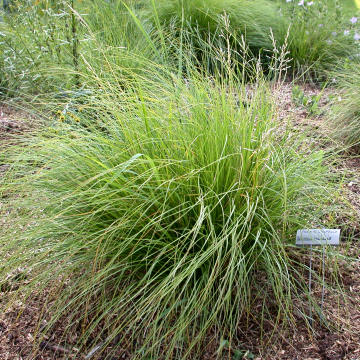

Sporobolus heterolepsis - (image 1 of 5)
Taxonomy
Family: Poaceae
Habitat
Mesic prairies. Hill prairies. Dry open ground, often in slight depressions.
Associates
Allium cernuum, Amorpha canescens, Andropogon gerardii, Andropogon scoparius, Aster azureus, Aster ericoides, Aster laevis, Cirsium discolor, Comandra umbellata, Coreopsis tripteris, Dodecatheon meadia, Eryngium yuccifolium, Gentiana puberulenta, Liastris aspera, Lithospermum canescens, Panicum virgatum, Parthenium integrifolium, Petalostemum candidum, Petalostemum purpureum, Phlox pilosa fulgida, Phystostegia virginiana arenaria, Prenanthes aspera, Pycnanthemum virginianum, Ratibida pinnata, Silphium integrifolium deamii, Silphium lacinatum, Silphium terebinthinaceum, Solidago rigia, Sorghastrum nutans, Stipa spartea, Verconicastrum virginicum.
Distribution
Ontario west to Saskatchewan, south to TN, AR and NM, and occasionally east to PA, CT, and Quebec.
Morphology
Perennial clumping grass, to 1m high. Leaves very long, narrow, usually involute, crowded toward the base. Spike an open panicle to 10-20 cm long and 1.5-3 cm wide, cylindric to narrowly ovoid, with whorled ascending, mostly racemiform branches. Spikelets egg-shaped, 3-6 mm long; first glume half as long as the second; second glume acuminate, usually slightly exceeding the lemma; palea usually slightly exceeding the lemma. Fruit hard, spherical.
Notes
Flowers early August to early September
Wetland indicator: Facultative Upland -
Grasses in the genus Sporobolus and some related genera have a pericarp that is free from the seed, similar to an achene. In most other grasses the pericarp adheres to the seed. The pericarp of S. heterolepsis is rigid, but in most other species in the genus Sporobolus the pericarp becomes gelatinous when wet and this helps the seed adhere to passing animals.
The heads smell like buttered popcorn when in anthesis. A highly ornamental grass that is slow to establish but long-lived. The seeds roll easily.
References
Clark, G. Lynn and Richard W. Pohl. 1996. Agnes Chase's First Book of Grasses: the Structure of Grasses Explained for Beginners. Fourth ed.
Smithsonian Institution Press. Washington and London
Gleason, Henry A. and A. Cronquist. 1991. Manual of Vascular Plants of
Northeastern United States
and Adjacent Canada. Second Ed.
The New York Botanical Garden. Bronx, NY
Knobel, Edward. 1980. Field Guide to the Grasses, Sedges and Rushes of the
United States. 2nd Ed.
Dover Publications, Inc. New York NY
Swink, F. and G. Wilhelm. 1994. Plants of the Chicago Region.
Indiana Academy of Science. The Morton Arboretum. Lisle, Illinois.
|
Michael Hough © 2005 |